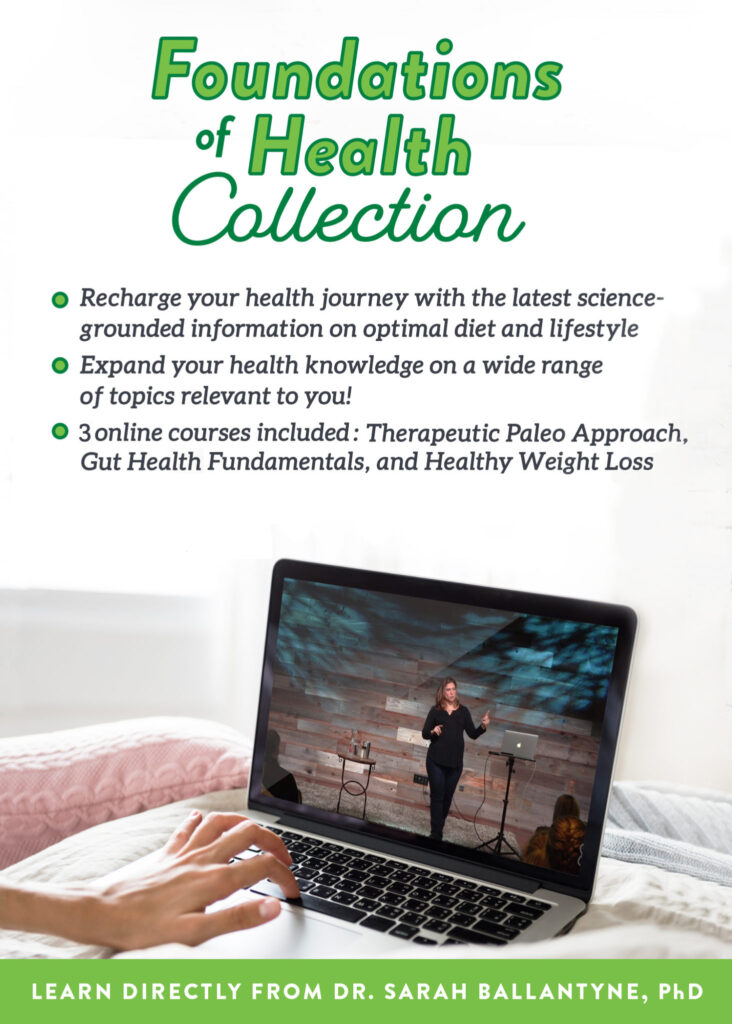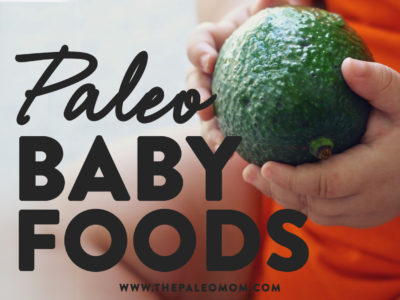You can absolutely start your baby off right by feeding them Paleolithic foods, properly cooked (when necessary) and mashed or pureed. There is really no compelling reason why you should ever introduce grains, as there are far more nutritious, easily digested foods that won’t irritate your baby’s sensitive digestive tract. So, here are some frequently asked questions by new moms thinking about introducing solids.
When should you introduce solid foods? The general rule of thumb is that you can introduce solids once your baby is at least 5 months old (6 months old is better), sitting up well, interested in your food, and you have the go ahead from your pediatrician. Watch closely for signs of choking and never leave a baby or toddler unattended while they are eating. You can help prepare your baby’s digestive tract for solids by breastfeeding exclusively (which helps provide probiotics and hormones and enzymes that help mature the digestive tract). You can also give them a small amount of acidophilus/bifidus (buy a capsule that you can break open, and rub a small pinch in their mouth before they nurse or take a bottle) once or twice a day, starting at about three months old (again, with the approval of your pediatrician). Many people prefer a baby-led weaning strategy, whereby you wait until your baby is able to self-feed soft finger foods (some babies will be able to do this as early as 5 or 6 months, but 8-10 months is more usual). The food lists below are still applicable to a baby-led weaning strategy, just cutting foods up into small pieces instead of pureeing.
What consistency should baby food be? First foods should be thinned with breast milk or formula and be very runny (it should pour off of a spoon and really be only slightly thicker than breast milk). Over the first few months, gradually increase the thickness of the baby food. By eight months old, most babies can start to handle a little texture in their baby food (think oatmeal consistency). By ten months old, most babies can handle a soft food, mashed with a fork. Sometime between 8 and 10 months old, you baby will probably show interest in some finger foods (like small pieces of soft fruit or cooked veggies). Watch your baby’s cues and don’t rush them.
What time of day should you feed your baby? Start with just one feeding a day, usually in the middle of the day, when you’re baby is not tired, and stop as soon as your baby is no longer interested. Your baby may only eat a few mouthfuls for those first few meals (or even few weeks of meals). You can also start to introduce sips of water at the same time as you are introducing foods, either from a cup (regular, sippy, straw) or spoon. Over the first few months, you can gradually increase the number of times a day that your baby is eating. By 9 or 10 months old, most babies will happily eat three solid meals a day and maybe even a snack or two.
Save 80% Off the Foundations of Health
Expand your health knowledge on a wide range of topics relevant to you, from how to evaluate scientific studies, to therapeutic diet and lifestyle, to leaky gut and gut microbiome health, to sustainable weight loss, and much more!!!

Being watchful for allergies. It can take several days for an allergic reaction to a food to present itself. Only introduce one new food every 4-7 days (on the longer side if there are food allergies in your family). You do not need to give that new food every day for those 4-7 days, one or two exposures is sufficient. There are many high-allergy foods like berries, tomatoes, nuts, shellfish, citrus, and egg whites that should wait until your baby is at least one-year old before introducing.
Is it easy to make your own food? Not only is it quite easy, it yields much more nutritious and tasty food for your baby. I like to make a fairly big batch of anything that I’m making and freeze tablespoons full (before thinning so that I can control the thickness as my baby gets older) in ice cube trays (once the food is frozen you can pop the cubes into a bag and label for easy defrosting later). Just make sure you aren’t refreezing anything (like freezing a mash made from steamed frozen vegetables).
Can you mix foods together? Absolutely! Play with different combinations! Something that might seem odd to you might be delicious to your baby! And most babies prefer one taste at one meal, so it’s a great way to increase variety. Just make sure that all the ingredients are ones you’ve introduced before (or at least all but one).
What are the best First Foods? The best first foods for your baby are mashed ripe avocado, mashed ripe banana, mashed cooked sweet potato, mashed cooked winter squash, pureed liver (preferably pastured/grass-fed) and pastured egg yolk. For babies at least six months old, very well pureed, well cooked meats (puree with broth or breast milk) and whole milk yogurt (especially from grass-fed cows) are excellent early foods.
What foods can you introduce when?
This list reflects the digestibility of the foods as well as the ease of preparing it with an appropriate texture for your little ones. This is a guide (adapted from Super Baby Food by Ruth Yaron, which I highly recommend even though I disagree with her dislike of feeding meat to babies and toddlers) and this is not intended to replace the advice of your pediatrician.
|
6 months old
|
7 months old
|
8 months old
|
|
Ripe avocado
|
Pastured Egg yolk
|
Ground nuts (if no allergy worries)
|
|
Ripe banana
|
||
|
Sweet potato
|
||
|
Winter Squash
|
Cooked, pureed:
|
Ground seeds
|
|
Asparagus
|
Tahini
|
|
|
Carrots
|
||
|
Cooked strained/pureed:
|
Green beans
|
|
|
Apple
|
Summer squash
|
Natural cheeses
|
|
Apricots
|
||
|
Nectarines
|
||
|
Peaches
|
Cottage cheese
|
Apricot
|
|
Pears
|
Apple
|
|
|
Plums and Prunes
|
Cantaloupe
|
|
|
Cooked/pureed fresh fish:
|
Honeydew
|
|
| Raw, pureed: |
Tilapia
|
Kiwi
|
| Mango |
Salmon
|
Plums
|
|
Papaya
|
Cod
|
Watermelon
|
|
Pears
|
Halibut
|
Broccoli
|
| Trout |
Okra
|
|
| Tuna |
Grapes (peeled and quartered)
|
|
| Pastured Egg yolk | Hake | |
|
Whole milk yogurt
|
||
|
Very well pureed meat:
|
||
| Liver | ||
|
Organ Meat
|
||
|
Lamb
|
||
| Chicken and Turkey | ||
|
Tender cuts of beef and pork
|
||
|
9 months old
|
10 months old
|
1 year old
|
|
Pineapple
|
Nut Butters (if no allergy worries)
|
Milk
|
|
Finely grated, raw:
|
||
|
Beets
|
Summer Squash
|
Citrus Fruits
|
|
Brussels sprouts
|
Carrots
|
|
|
Cauliflower
|
Greens
|
|
|
Eggplant
|
Bell Peppers
|
Tomatoes
|
|
Kale
|
||
|
Spinach
|
||
|
Rhubarb
|
Egg white
|
|
|
Rutabaga
|
||
|
Turnips
|
||
|
Honey
|
||
|
Cooked onion
|
||
|
Berries
|




 Chocolate Chip “Oatmeal” Cookies
Chocolate Chip “Oatmeal” Cookies